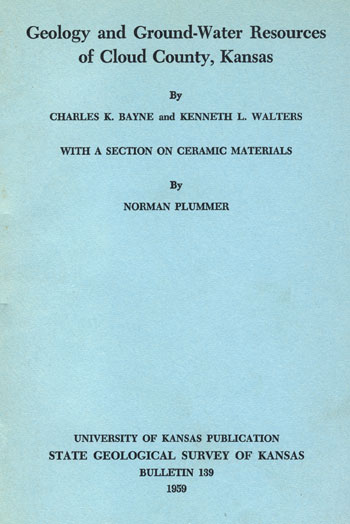Geology and Ground-water Resources of Cloud County, Kansas
By Charles K. Bayne and Kenneth L. Walters
With a Section on Ceramic Materials by Norman Plummer

Originally published in 1959 as Kansas Geological Survey Bulletin 139. This is, in general, the original text as published. The information has not been updated.
You may also wish to visit our web site on the Cloud County geologic map.
Abstract
This report describing the geography, geology, and ground-water resources of Cloud County, Kansas, is based on hydrologic and geologic information obtained in the field during the fall of 1953 and the summer of 1954. The field data are given in tables; they include records of 170 wells, chemical analyses of water from 57 representative wells, and logs of 76 test holes. In addition, 100 holes were augered to determine the depth to water.
Cloud County has an area of about 711 square miles and in 1950 bad a population of 16,104. The county lies in the Dissected High Plains section of the Great Plains physiographic province. Most of it is drained by Republican and Solomon Rivers. A small part is drained by Chapman Creek. The normal annual precipitation at Concordia is 25.24 inches, and the mean annual temperature is 53.8° F. Agriculture is the principal occupation in the county.
The rocks that crop out in Cloud County are sedimentary and range in age from Cretaceous to Recent. The oldest formation exposed in the county is the Dakota Formation. The youngest Cretaceous formation exposed in the county is the Carlile Shale. The Ogallala Formation, of Tertiary age, is present as small remnants in a few places. The Cretaceous rocks are mantled in many places by unconsolidated continental deposits of fluviatile and eolian origin representing four stages of the Pleistocene Epoch.
The unconsolidated sand and gravel deposits of Pleistocene age form the principal aquifers in the county. These deposits are best developed in the valley of Republican River. The Dakota Formation yields moderate quantities of water, but Cretaceous rocks overlying the Dakota Formation yield very little water in the county. Where it is deeply buried the Dakota Formation contains salty water, which is being discharged into the valley fill of Republican River near Concordia.
Ground water in the area is recharged principally from local precipitation; underflow from adjacent areas contributes significantly, however. Ground water is discharged mainly by seepage into streams and by transpiration by plants; there is some discharge by underflow across the eastern boundary of the county. All municipal and industrial water supplies and most domestic and stock supplies are obtained from wells. Irrigation from wells is practiced extensively in the valley of Republican River, and to a lesser extent in the Solomon River valley.
Kansas Geological Survey, Geology
Placed on web June 29, 2009; originally published May 1959.
Comments to webadmin@kgs.ku.edu
The URL for this page is http://www.kgs.ku.edu/General/Geology/Cloud/index.html